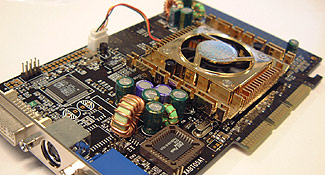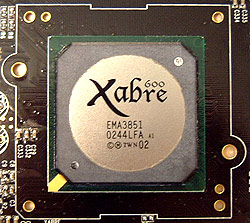SiS Xabre600 Reference Videocard Review
When SiS released the Xabre400 GPU earlier this year, it
was a huge step forward for budget-minded gamers. Today SiS officially releases the Xabre600 GPU
which is basically a shrunken, beefed up version of the original Xabre400.
 Based on a 0.13 micron technology core running at 300 MHz the new Xabre600
is an evolutionary advancement of the older 250 MHz 0.15 micron process, Xabre400 core.
Based on a 0.13 micron technology core running at 300 MHz the new Xabre600
is an evolutionary advancement of the older 250 MHz 0.15 micron process, Xabre400 core.
The
Xabre600 reference card we are examining is backed up with 64MB of DDR memory. The memory
is made by Hynix and runs in sync with the GPU at 300 MHz - what
SiS call the "Duo300".
The Xabre600 boasts
Pro8x8, so like it's predecessor, it is both DirectX8 compatible and 8x AGP compatible. DirectX
8 compatibility means that games which take advantage of the Xabre's pixel shaders should look more
vibrant and lifelike. Whereas, 8x AGP effectively doubles the bandwidth available on the AGP bus
to the videocard.
With 8X AGP compatible motherboards, bandwidth will increase from 1.06 GB/s (4xAGP) to 2.1
GB/s, so in theory it should boost performance because the videocard can compute
more data. So far though, we haven't seen much of a performance boost from any manufacturers
8X AGP solution.
SiS
implement a few new features with the Xabre600 GPU that should make
it standout in the sea of mainstream videocards. The first of which to
catch our eye is something called the "Vertexlizer Engine," but the XmartAGP, XmartVision and XmartDrive technologies are also
important.
| Xabre600 Technology |
|
| XmartDrive |
Automatically senses and adjusts system speed for
3D environments by 10-50MHz. |
| XmartVision |
Automatically senses and adjusts light for 3D
applications. Basically, RGB signal strength is adjusted from 700mV to
800mV in 3D applications for a sharper picture
signal. |
| XmartPower |
Controls fan speed based on applications running, with higher RPM's
for 3D applications to increase cooling. |
| XmartAGP |
Automatically adjusts card to 8X, 4X, 2X AGP
based on performance criteria with host machine. 8X AGP has the best signal strength, and thus
image quality of the thee standards. |

In laymens terms the Vertexlizer Engine is a hardware and
software based solution which "increases efficiency while reducing GPU loading."
Essentially, the hardware part of the Vertexlizer Engine (about 30%) resides on
the GPU, and the software side makes use of the computers own processor (about
70%) to offload work.
To
underline this point, the Xabre600 is fairly CPU dependent, but as you
upgrade your processor the performance of the card is also increased. The reverse is
true of course, but to put things in perspective, if the computer is based
on a 1.8GHz Pentium 4 processor you should see performance on the level of a GeForce MX440-8X. A 2.0GHz P4 will
bring performance levels to the scale of an ATI Radeon 9000 Pro, and a 2.8GHz
P4 yields performance on the scale of an Nvidia GeForce 4 Ti4200 videocard according to
SiS.
Basically, the Xabre600 seems to benefit from a 10% performance gain in vertex shading for ever 200-250MHz CPU
power. This CPU dependency is not necessarily a bad thing as DirectX can use CPU resources to
emulate Vertex Shaders without much of a noticeable performance hit.
SiS introduced this hardware optimized Vertexlizer Engine as a best-fit scenario, and also to keep the card as affordable
as possible. Less transistors on the core translate into higher yields, lower electrical requirements, and better
thermals.
SiS'
XmartDrive feature is actually quite an ingenious! When working with 2D based applications,
the Xabre600 will automatically throttle down the clock speed by anywhere
from 10-50MHz, and when the computer loads up a 3D application it will
raise the core speed back up to stock levels. This results in a power saving, and
helps to prolong the lifespan of the videocard.
The power savings we mentioned may not be
significant for a desktop computer, but SiS tell us they plan on launching the
Xabre600 into the mobile GPU markets where power consumption is a major
point.

